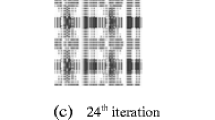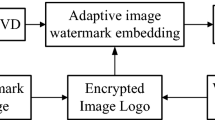Abstract
A novel imperceptible, secure and robust grayscale image watermarking scheme using Lagrangian twin support vector regression (LTSVR) and genetic algorithm (GA) in discrete Cosine transform (DCT) domain is presented in this manuscript. Fuzzy entropy is used to select the relevant blocks for embedding the watermark. Selected number of blocks based on fuzzy entropy not only reduces the dimensionality of the watermarking problem but also discards redundant and irrelevant blocks. Significant DCT coefficients having high energy compaction property of each selected block are used to form the image dataset to train LTSVR to find the non-linear regression function between the input and target vector. The adaptive watermark strength, different for each selected block, is decided by the GA process based on well defined fitness function. Due to good learning capability of image characteristics and high generalization property of LTSVR, watermark is successfully extracted from the watermarked images against a series of image processing operations. From the experimental and comparison results performed on standard and real world images, it is inferred that the proposed method is suitable for copyright protection applications where high degree of robustness is desirable.









Similar content being viewed by others
References
Agarwal C, Mishra A, Sharma A (2013) Gray- scale image watermarking using GA-BPN hybrid network. J Vis Commun Image Represent 24(8):1135–1146
Ali M, Ahn CW, Pant M (2014) A robust image watermarking technique using SVD and differential evolution in DCT domain. Optik 125(1):428–434
Aslantas V (2008) A singular value decomposition based image watermarking using genetic algorithm. Int J Electron Commun 62(5):386–394
Avci E, Avci D (2009) An expert system based on fuzzy entropy for automatic threshold selection in image processing. Expert Syst Appl 36:3077–3085
Balasundaram S, Tanveer M (2013) On Lagrangian twin support vector regression. Naural Comput Appl 22:S257–S267
Chu WC (2003) DCT based image watermarking using subsampling. IEEE Trans Multimedia 5(1):34–38
Cox IJ, Kilian J, Leighton FT, Shamoon T (1997) Secure spread spectrum watermarking for multimedia. IEEE Trans Image Process 12(6):1673–1687
Eyadat M, Vasikarla S (2005) Performance evaluation of an incorporated DCT block-based watermarking algorithm with human visual system model. Pattern Recogn Lett 26(11):1405–1411
Huang H-C, Chu C-M, Pan J-S (2009) The optimized copyright protection scheme with genetic watermarking. Soft Comput 13:333–343
Klir GJ, Yuan B (1995) Fuzzy sets and Fuzzy logic: theory and applications. Prentice Hall, New Jersey, Msm
Kumar R, Das RR, Mishra VN, Dwivedi R (2011) Fuzzy entropy based neuro-wavelet identifier-cum-quantifier for discrimination of gases/odors. IEEE Sensors J 11(7):1548–1555
Lee HM, Chen CM, Chen JM, Jou YL (2001) An efficient fuzzy classifier with feature selection based on fuzzy entropy. IEEE Trans Syst Man Cybern 31(3):426–432
Lian SU, Hong MA, Shifu T (2006) Adaptive image digital watermarking with DCT and FCM. Wuhan Univ J Nat Sci 11(6):1657–1660
Maity SP, Maity S, Sil J, Delpha C (2013) Collusion resilient spread spectrum watermarking in M-band wavelet using GA-fuzzy hybridization. J Syst Softw 86(1):47–59
Mangasarian OL (1994) Nonlinear programming. SIAM, Philadelphia
Mangasarian OL, Musciant DR (2001) Lagrangian support vector machines. J Mach learn Res 1:161–177
Mangasarian OL, Musicant DR (2001) Lagrangian support vector machines. J Mach Learn 1:161–177
Mehta R, Rajpal N, Vishwakarma VP (2015) Robust image watermarking scheme in lifting wavelet domain using GA-LSVR hybridization. Int J Mach Learn Cybern. doi:10.1007/s-13042-015-0329-6, Springer Verlag
Mehta R, Rajpal N, Vishwakarma VP (2015) A robust and efficient image watermarking scheme based on Lagrangian SVR and lifting wavelet transform. Int J Mach Learn Cybern. doi:10.1007/s-13042-015-0331-z, Springer Verlag
Mehta R, Rajpal N, Vishwakarma VP (2015) Gray scale image watermarking using fuzzy entropy and Lagrangian support vector regression in DCT domain. Int J Appl Pattern Recog 2(3):255–279
Meng F, Pei Z, Wang J (2008) A novel blind image watermarking scheme based on support vector machine in DCT domain. In: IEEE international Conference on Computational Intelligence and Security, pp 16–20
Murphy PM, Aha DW (1992) UCI repository of machine learning databases. University of California: Irvine, http://www.ics.uci.edu
Nikolaidis N, Pitas I (1998) Robust image watermarking in the spatial domain. Signal Process 66(3):385–403
Peng H, Wang J, Wang W (2010) Image watermarking method in multiwavelet domain based on support vector machines. J System Softw 83(9):1470–1477
Petitcolas FAP (2000) Watermarking schemes evaluation. IEEE Signal Process Mag 2000:58–64
Piao CR, Beack S, Woo D-M, Han S-S (2006) A blind watermarking algorithm based on HVS and RBF neural network for digital image. Lect Notes Comput Sci 4221:493–496
Shen R, Fu Y, Lu H (2005) A novel image watermarking scheme based on support vector regression. J Syst Softw 78(1):1–8
Tao H, Zain JM, Ahmed N, Hingwu Q (2010) An implementation of digital image watermarking based on particle swarm optimization. Commun Comput Inf Sci 87:314–320
Wu L, Deng W, Zhang J, He D (2009) Arnold transformation algorithm and anti Arnold transformation algorithm. In: Proc. of 1st International Conference on Information Science and Engineering (ICISE), pp 1164–1167
Xianghong T, Shuqin X, Qiliang Li (2003) Watermarking for the digital images based on model of human perception. In: IEEE International Conference on Neural Networks & Signal Processing, pp. 1509–1512.
Yadav A, Mehta R, Kumar R (2015) Gray scale image watermarking using fuzzy entropy and lagrangian twin SVR in DCT domain. In: IEEE International Conference on Contemporary Computing, pp. 19–24. doi:10.1109/IC3.2015.7346646
Author information
Authors and Affiliations
Corresponding author
Rights and permissions
About this article
Cite this article
Yadav, A.K., Mehta, R., Kumar, R. et al. Lagrangian twin support vector regression and genetic algorithm based robust grayscale image watermarking. Multimed Tools Appl 75, 9371–9394 (2016). https://doi.org/10.1007/s11042-016-3381-7
Received:
Revised:
Accepted:
Published:
Issue Date:
DOI: https://doi.org/10.1007/s11042-016-3381-7




